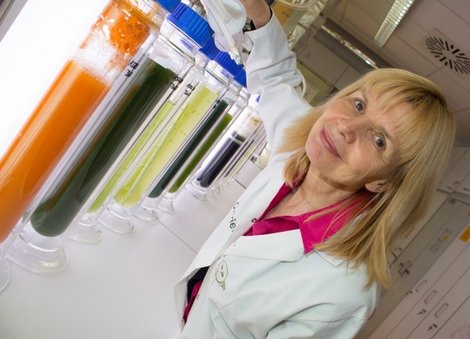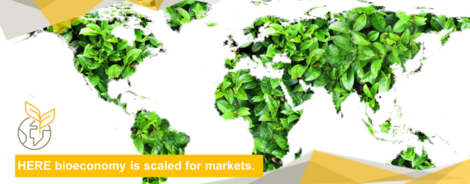Microalgae – Sustainable Raw Materials for the Bioeconomy

- Microalgae biomass is an essential source of raw materials for the production of a wide range of products during the transition from an oil-based to a biobased economy.
- As photosynthetically active organisms, microalgae use the sun’s energy and can be grown in translucent containers known as photobioreactors, where they convert the greenhouse gas CO2 into valuable biomass without the need to use arable land.
- To achieve the best possible added value, algae biomass refineries need to be developed that make full use of the raw material, in a similar way to oil refineries. Research into this area is being carried out by the algae team at the Anhalt University of Applied Sciences.
The amount of oil, coal and gas that the world’s population uses in a year took at least one million years to form. The age of fossil raw materials, which currently cover almost 80% of our energy requirements and are used to manufacture many everyday products, is gradually coming to an end.
The task of the bioeconomy is to convert the cycles of fossil materials into a biobased economy with renewable raw materials. Because of the limited amount of agricultural land available, the growing demand for biomass for use as food, a source of active substances, an industrial raw material and a fuel cannot be met simply by growing plants.
An alternative source of raw materials is biomass from microalgae, which can be produced almost all year round in aqueous culture media in photobioreactors using light and CO2. Because of their short doubling times, microalgae produce larger harvests of biomass than land plants (50-150 t/ha per year, compared with 6-9 t/ha for wheat and 3-5 t/ha for rape), capture more CO2 and do not need agricultural land (therefore, they do not compete with food production). After dewatering, the biomass can be used as a raw material.
What are algae and how are they used?
Algae (from the Latin alga, which means seaweed) are simple aquatic organisms that can take the form of microscopically small microalgae or macroalgae, which are several meters long.
Macroalgae (all brown, many red and a few green algae species) mainly grow in the sea. They are used to make sushi, alginates, textiles and cosmetics and are cultivated manually in shallow lagoons. This is known as mariculture.
Microalgae include prokaryotic cyanobacteria (blue-green algae) and single-celled eukaryotic algae, such as diatoms, chrysophyta and green and red algae. These tiny organisms mostly float in the water in the form of phytoplankton and are responsible for almost half the photosynthesis and oxygen production on earth. In the process, they capture large quantities of CO2 and have a major impact on the climate.
Currently around 44,000 species have been identified, but only a few have been characterized in more detail. Experts believe that there are more than 500,000 undiscovered species, which offer almost inexhaustible potential for use in biotechnology. The individual classes are not closely related and have very different metabolic pathways and product ranges. Many species form substances that cannot be extracted from plants.
Compared with arable farming, the industrial production of microalgae is still a young discipline. It began in 1960 and has been increasing in size every year. Currently only a few microalgae are used commercially. They are sold primarily as food supplements and animal feeds in the form of biomass. The production of starting materials is still in its early days and is restricted to high-quality products such as Omega 3 fatty acids, natural dyes and cosmetic extracts.
There is huge market potential for active pharmaceutical substances, specific carbohydrates, proteins, bioplastics and oils. A wide range of materials that are currently manufactured using oil can be made from algae. For this to be possible, the entire process chain from cultivation through to processing needs to be made more efficient, in order to reduce the production costs, which are still high. One important approach is the development of biorefineries for algae biomass, which will make full use of the raw material and recycle the residual waste flows in a similar way to oil refineries.
Curriculum vitae
Prof. Dr. Carola Griehl is a professor of biochemistry, head of the Competence Center Algal Biotechnology and director of the Life Science Center at Anhalt University of Applied Sciences. Her research focuses on developing more efficient processes for producing algae biomass and for extracting starting materials (proteins, carotinoids, sulfolipids, hydrocarbon oils, bioplastics and active substances) for use on a laboratory scale and in technical centers. She is also investigating using the waste from the processes to make biogas.
Further information
Competence Center Algal Biotechnology at Anhalt University of Applied Sciences
Dechema working group for algal biotechnology
- dechema.de/en
Author: Prof. Dr. Carola Griehl, Anhalt University of Applied Sciences

Sustainable economic growth requires the responsible use of resources. This is a reality in Saxony-Anhalt: more than half of gross electricity production comes from renewable sources of energy.
> Learn more about bioeconomy in Saxony-Anhalt and the strength of Saxony-Anhalt as a location for bioeconomy.
